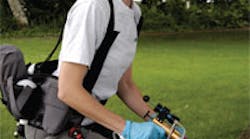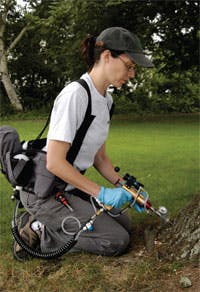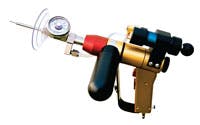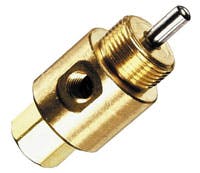North America is under attack! With names like the Hemlock Woolly Adelgid (HWA), Asian Longhorned Beetle (ALB), and Emerald Ash Borer (EAB), these non-human aggressors are out to destroy one of our most treasured resources — trees. The EAB has already killed more than 20 million trees in Michigan alone, and tens of millions more in surrounding states.
The HWA is threatening the Eastern and Carolina Hemlock tree population located from the Great Smoky Mountains north to the mid-Hudson River Valley and southern New England. These insects reportedly arrived from Asia and began moving up the eastern coast, wiping out most of the 90 million hemlock trees in the area. The ALB is a little less selective. It grows and reproduces in deciduous hardwood trees like maple, ash, elm, birch, poplar, and willow. The larvae bore holes through the inside of the tree and eventually kill it.
The battle is on
Several courses of action have been implemented to stop the invasive insects. One is to cut down trees as they become infected, or even before. The intent is to isolate infested areas, but many experts view this action as simply delaying the inevitable. It is also expensive, as it costs hundreds of dollars to cut down each tree, and a new tree cannot be planted for many years.
Another procedure is to treat soil around the tree with a solution that will impede infestation into the tree. However, because the solution is not applied directly into the tree, its effectiveness can be compromised, and it can also migrate into adjacent soil and bodies of water.
A method that is more effective and less costly than either of these is to inject insecticide directly into the tree. This is done by drilling a small hole into the trunk of the tree, inserting a plug, then injecting the insecticide using a Quikjet device from Arborjet Inc., Woburn, Mass.
A powerful punch
Powered by compressed air, the Quik-jet injects the appropriate solution into the trunk of a tree, where the tree’s vascular system will carry it throughout the tree. Once the injection is made, the drilled hole is sealed. A compressor carried by a shoulder strap provides air at 50- to 150-psi, which is selected based on the application by an arborist or other industry professional.
When the operator pulls a trigger, compressed air flows into a MAV-2 two-way, normally closed cartridge valve manufactured by Clippard Instrument Laboratory Inc., Cincinnati. The valve has a plunger that shifts from fully closed to fully open with only 1/8-in. of travel and only 24-oz of force, so it can be operated directly by hand.
From the valve, air flows into one end of a cylinder, where the pressurized air acts against one side of a piston to push the appropriate arborjet fluid out the other end of the cylinder. This cylinder was also designed and manufactured by Clippard. Clippard supplies Arborjet with a standard cylinder with a tapered end cap to accommodate the geometry of the Quik-jet.
Arborjet had been using a standard cylinder form a different supplier, only to have to modify the cylinders to suit the application. They began searching for a source that could supply customized cylinders, and found that Clippard met their needs — and at no price increase to Arborjet. In addition to valves and cylinders, Clippard also supplies miniature fittings for the application.
Catching on
Even though the EAB had not been found in Milwaukee County in May 2009, the city of Milwaukee launched an effort to protect its 36,000 ash trees from the advancing EAB by using Arborjet’s device. The efforts paid off, as the EAB was found in Milwaukee county in August. Mayor Tom Barrett explained, “It’s much more expensive than $40 to cut down a tree. We’d rather spend the $40 [each] to make sure they live.”
For more information on Clippard’s products and engineering services, call (513) 521-4261, or visit www.clippard.com.
Click here to view a video on Arborjet's Quikjet.




